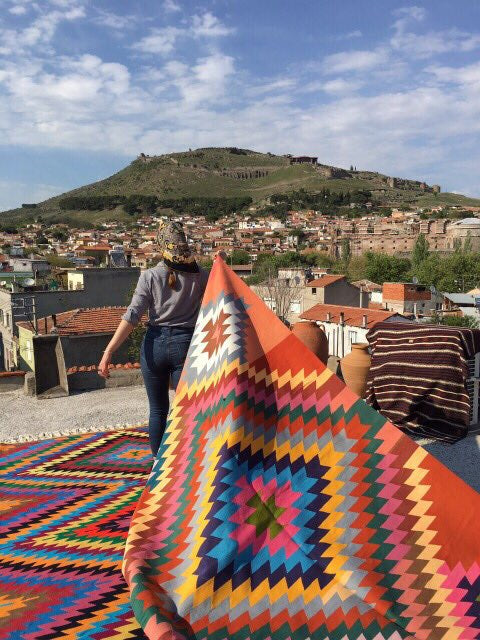
In the colorful tapestry of Turkish culture, one finds the threads of an ancient tradition that has woven its way through centuries – the art of Turkish kilim weaving. Originating from a rich historical tapestry, Turkish kilims are not just floor coverings; they are cultural artifacts that tell a story of heritage, craftsmanship, and the intricate artistry of the Anatolian people.
The roots of Turkish kilim weaving extend far back into the annals of history. While pinpointing an exact starting date can be challenging, evidence suggests that the art of kilim weaving in Turkey dates back over a millennium. Nomadic tribes and settled communities alike embraced this form of textile creation as an integral part of their daily lives.
The nomadic lifestyle of many Turkish tribes played a crucial role in the development of kilim weaving. These skilled artisans, often women, utilized weaving techniques passed down from generation to generation. The portability and practicality of kilims made them an indispensable part of nomadic life, serving various purposes such as floor coverings, wall hangings, and even as storage bags for belongings during migrations.
One of the most captivating aspects of Turkish kilims is the intricate and symbolic designs that adorn them. Each region and tribe developed its unique patterns, colors, and motifs, often reflecting the cultural identity and beliefs of the weavers. From geometric shapes to stylized flora and fauna, every kilim tells a story of the people who wove it.
As centuries passed, Turkish kilim weaving evolved, blending traditional craftsmanship with external influences. Different regions of Turkey developed their own distinct styles, creating a diverse and vibrant array of kilims. The art form became not only a practical necessity but also a means of artistic expression, with weavers experimenting with colors, patterns, and techniques.
In the modern era, Turkish kilims continue to be celebrated for their timeless beauty and cultural significance. Artisans across Turkey are dedicated to preserving the ancient techniques, ensuring that the art of kilim weaving remains a living tradition. These master weavers often incorporate contemporary elements into their work, bridging the gap between tradition and modernity.
The story of Turkish kilim weaving is a testament to the enduring spirit of a people and their dedication to preserving cultural heritage. From the nomadic tribes of ancient Anatolia to the bustling cities of contemporary Turkey, the art of kilim weaving stands as a vibrant thread connecting past and present. As we admire the intricate designs and vibrant colors of Turkish kilims today, we also celebrate the resilience of a tradition that has weathered the sands of time


0 comments